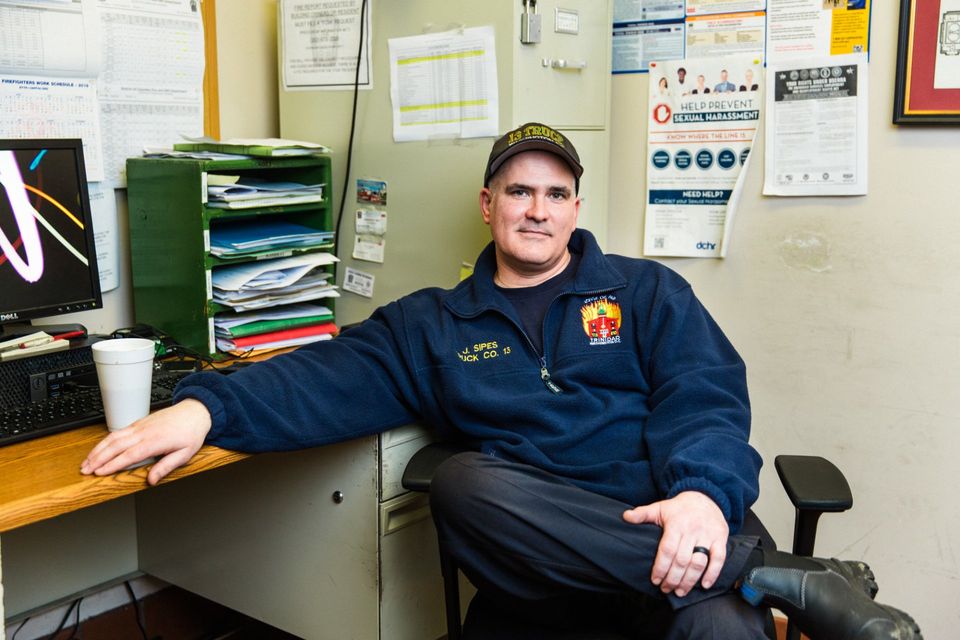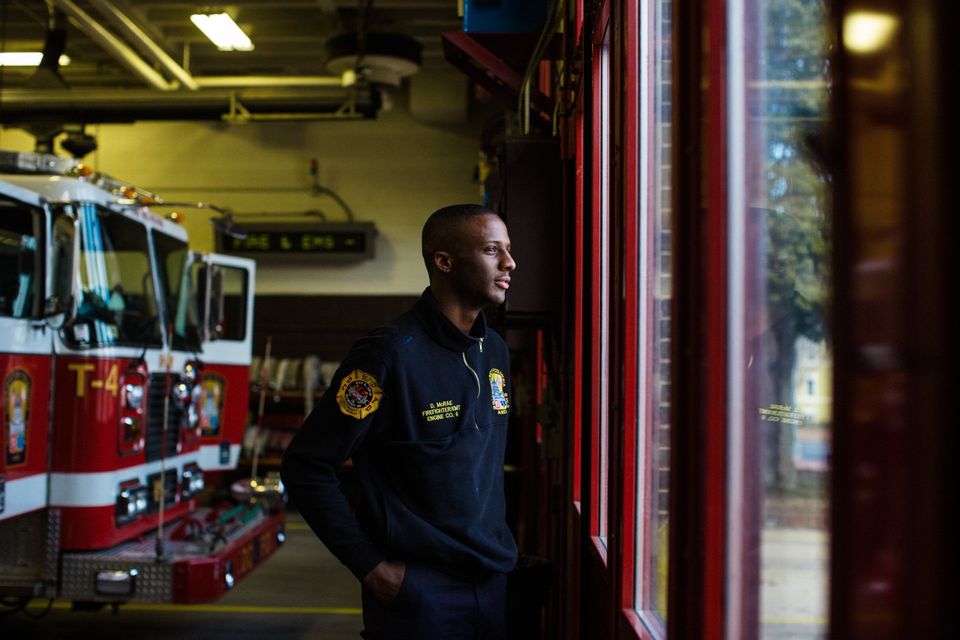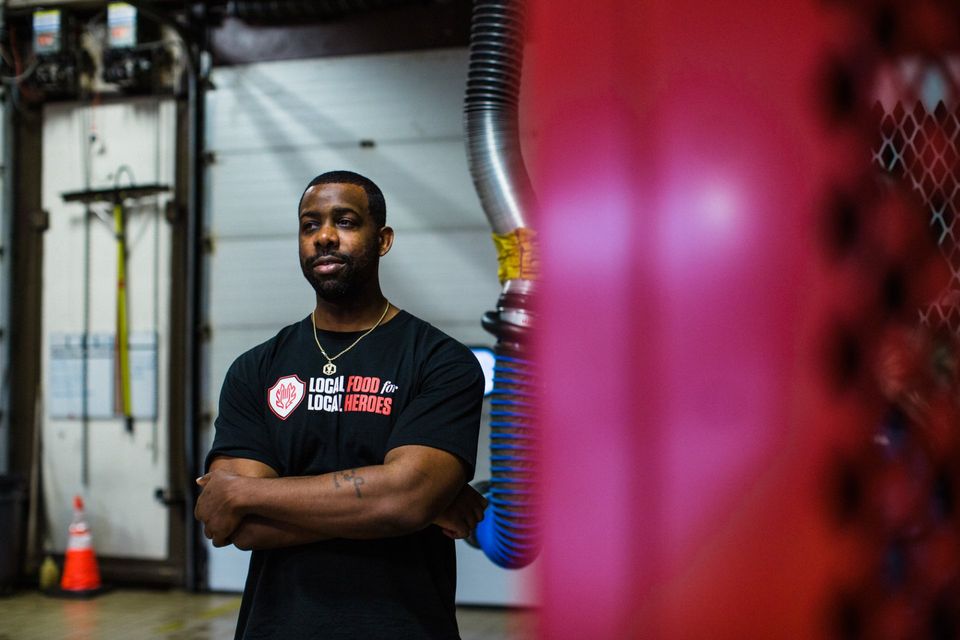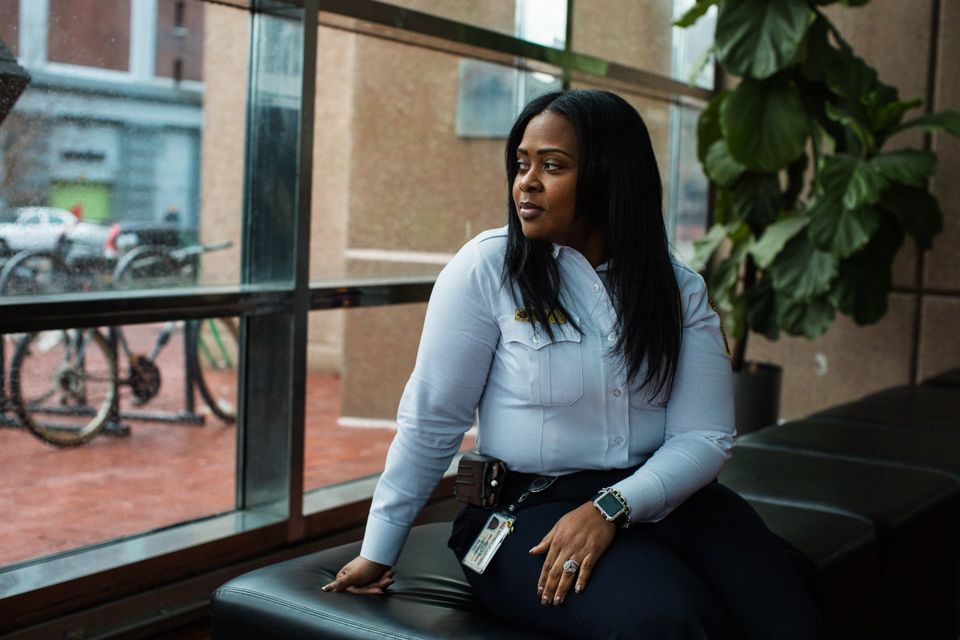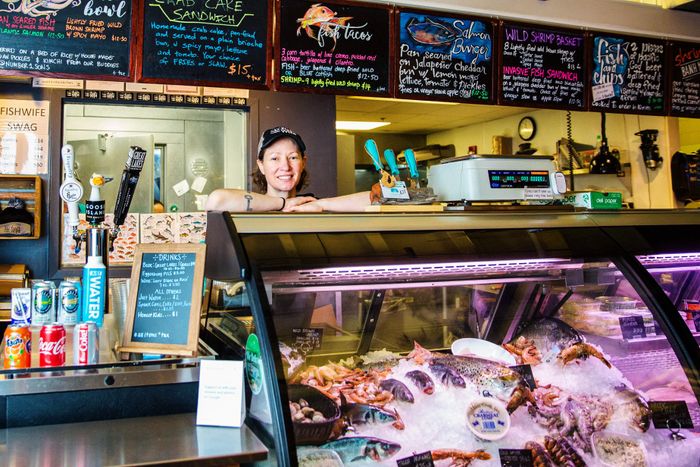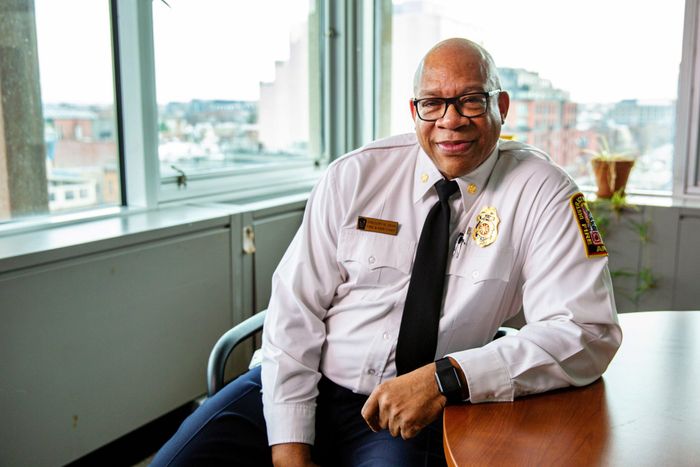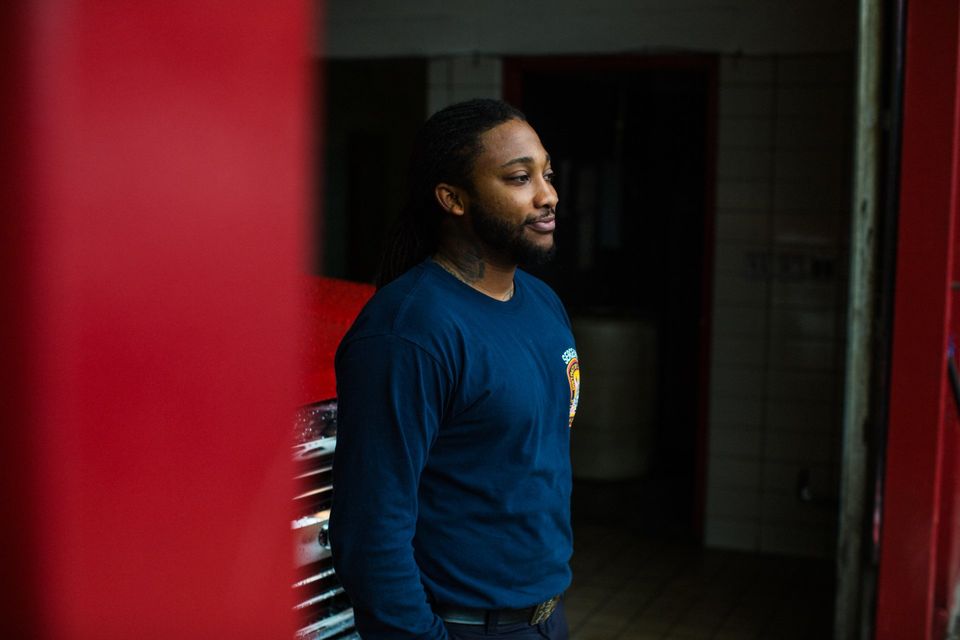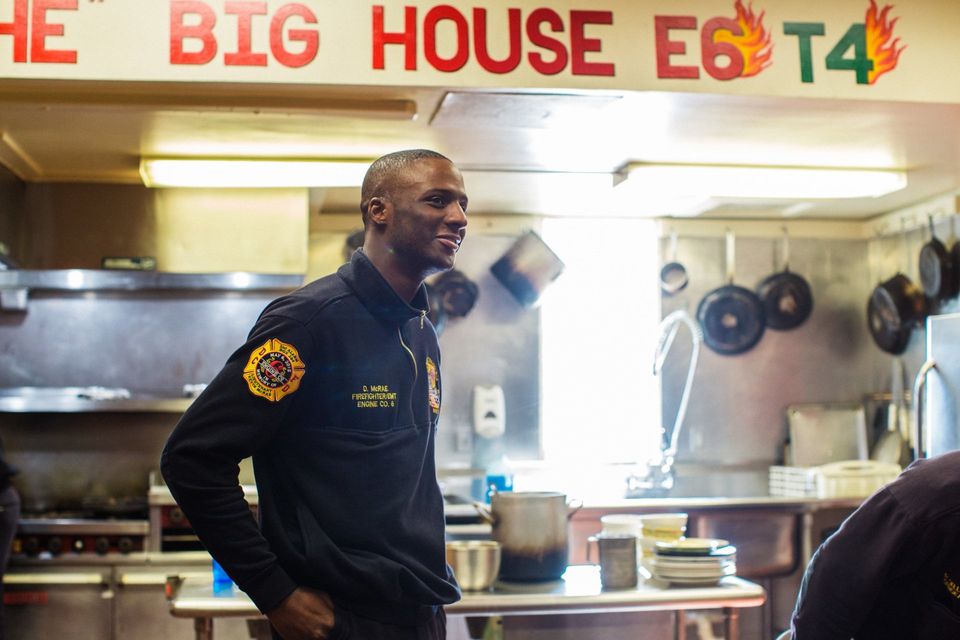THE HEART OF THE FIRE SERVICE
Story by Kate Schmidgall
| Photographs by
Erica Baker
The Day Of
Every May 6th, the entire company of Engine 6 and Truck 4 visits the gravesite of Lieutenant Kevin McRae. They clean up the callbox that sent him to his final call and lay flowers. This year will be their fourth time.
A memorial patch is worn in his honor and the engine itself carries his name in the decal. “He always had everybody laughing, no doubt about that,” remembers one of his crew, “and all his guys would follow him anywhere. He had that kind of reputation. He took care of his men and they'd follow him anywhere. That's high respect to get in this fire service, and he had it.”
Box 264 is a short documentary about heart disease in the fire service. Directed by Dave Baker
Lieutenant McRae was 44-years-old when he died, just moments after fighting an apartment fire at 1330 7th Street NW. A day earlier, he had taken his 18-year-old son, Da’Von, to get fitted for a tux for prom.
“He went in the wrong building, thinking that's where the fire was,” Da’Von tells me. “He had to run up to the ninth floor of that building, run back down the steps, go in the correct building, run all the way up in the ninth floor of that building, help assist, put the fire out, give commands over the radio…” Da’Von trails off. “He assisted putting the fire out. They did good on that. I think there were like two, three rescues that day. When he came back outside, he just collapsed right in front of the building. He just collapsed, and that was the end of that.”

A memorial box honoring Lt. Kevin McRae sits in the watch room at 6 Engine firehouse in New Jersey Ave, NW. Photograph by Erica Baker
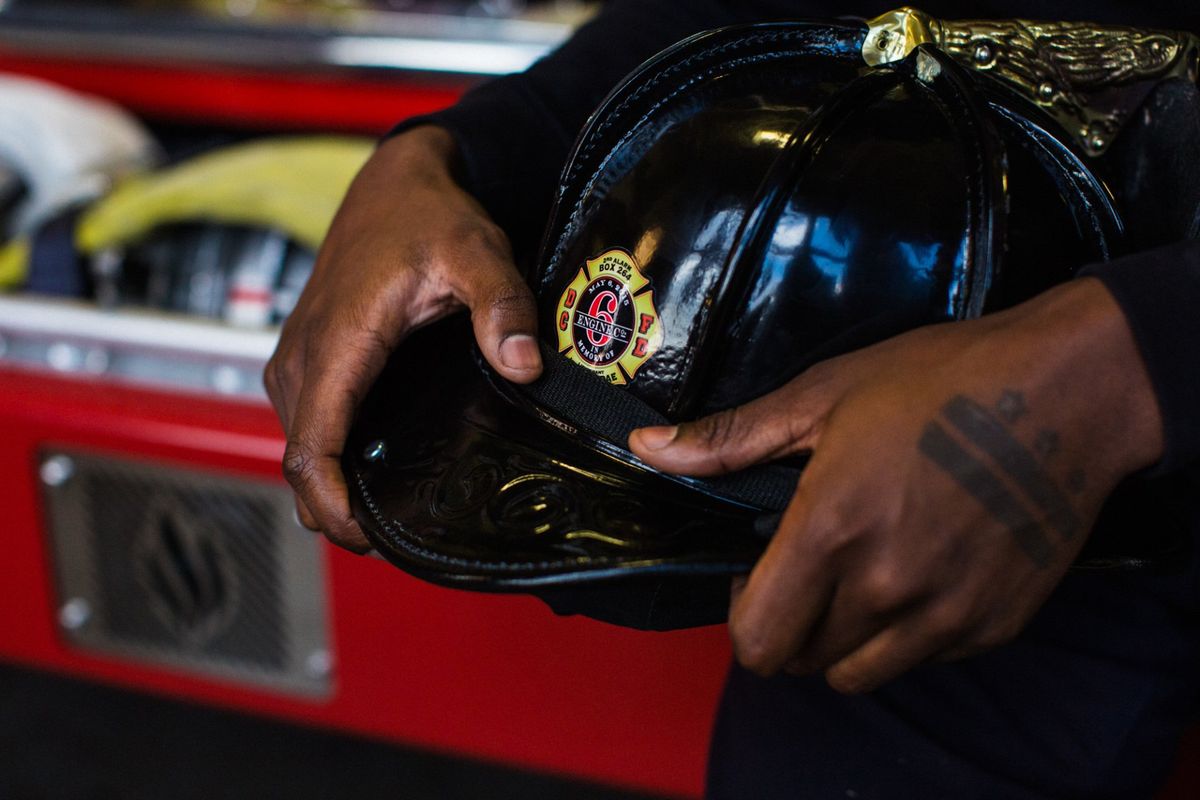
Da'Von holds his fire helmet with a decal in remembrance of his father, Lt. Kevin McRae, and the incident that took place on May 6, 2015. Photograph by Erica Baker
Nationwide, the leading cause of death for firefighters isn’t fire, or even cancer—it’s heart disease. The official cause of Lieutenant McRae’s death was a heart attack.
“Heart attacks, for us, it's an epidemic,” says Lieutenant Jan Sipes of Engine 10, Truck 14 (Truck 13) company, located at 10th and Florida NE and known for more than a century as ‘The House of Pain.’ Lieutenant Sipes is the health and safety co-chair of DC Firefighters Association, IAFF Local 36, the National Firefighter Association’s DC chapter and has been actively involved in issues of health and wellness in the fire service for the past sixteen years.
“Kevin's death really hit the department to the core,” he says. “I think there's a lot of soul-searching a lot of guys have done: ‘Can I do something to prevent that? Was his preventable? Is it preventable for me? Do I have anything going on that I can do better? Maybe I should pay more attention to my cholesterol levels, or my blood screens, or my body weight or exercising.’”
Lt. Jan Sipes is the health and safety co-chair of DC Firefighters Association, IAFF Local 36, and has been actively involved in issues of health and wellness in the fire service for the past sixteen years. Photograph by Erica Baker
Months after his prom tuxedo fitting, Da’Von entered the cadet program—a paid-training track for students graduating from DC public schools to join the fire service—and became a firefighter/EMT. Like his father was, Da’Von is stationed at The Big House.
Just two years in, he’s seeing firsthand the challenges of health and wellness in the fire service: “A lot of people just let themselves go. They don't stay active, they don't exercise or nothing like that. Health is probably the number one issue within the fire services,” he says.
“You got to stop doing what you're doing as far as eating and not being healthy,” he challenges.
Da'Von McRae at "The Big House" – Engine 6, Truck 4. Photograph by Erica Baker
“Do it for your family. You don't want your family weeping over the casket because you decided to eat wrong in this profession knowing how much physical labor it requires to be a fireman. It's like night and day basically—you could be asleep and then waking up to work a fire and you’ve got to be ready to operate. Your heart has got to be able to sustain all of that.”
Da'Von McRae
DC Firefighter/EMT
The call lights flash and the dispatcher says over the intercom, “Engine 6, respond for the call. North Capitol Street and New York Avenue West. Medical local L S response. Engine 6, respond for the call...”
And with that Da’Von runs out the room and hits the pole.
Firefighter Jonathan Tate helps Engine 9 fold their hose and put it back on the engine after putting out a fire. Photograph by Erica Baker
Heart of the Matter
Lieutenant McRae’s death forever changed the lives of his family, rattled the department, and somewhere deep, lit a fire inside firefighter Jonathan Tate.
Son of a DC fire chief, firefighter Tate has made improving health and wellness in the fire service his personal mission: “In nine years of retirement, my dad had three heart attacks and cancer. He never really got to enjoy his retirement after 32 years on the job. I saw the strongest man I knew go to the weakest man that I knew. He couldn't help himself off the toilet or get from the bedroom to the bathroom without being out of breath. Between him, and Lieutenant McRae, it really drove me to try to make an impact in health and wellness in the fire service because it's definitely needed.”
For this purpose, in Fall of 2018, firefighter Tate launched an initiative with a peculiar name, ‘Food on the Stove’: “It’s a double entendre—it's something we hear on a daily basis, the reason for the majority of calls we receive, but we really need to also pay attention to the food that we have on our stove in the firehouse,” he says.
Jonathan Tate, Founder of Food on the Stove. Photograph by Erica Baker
Having spent eleven years in the firehouse with Engine 15 and married to a lieutenant, EMS Captain Melonie Barnes couldn’t agree more and gets to the heart of it: “Most people think that firefighters die from fighting fire or getting burnt up in fires. In all actuality, they die from cardiac arrest, overexertion with fighting the fire, not necessarily the fire itself. And their heart disease is purely preventable by living a healthier lifestyle and making better food choices.”
“Most fire departments are known for having great cooks,” adds Captain Barnes. “We cook a lot of food, a lot of good food, a lot of soul food, a lot of hearty food to sustain the firefighters throughout the day, however, it's not always a healthy choice.”
Sitting down for lunch with the crew at Engine 6, the menu today is homemade ham and bean soup and grilled cheese sandwiches. I ask what the favorites of the house are and “Meatloaf!” is the first answer, followed by, “Pancakes! Shrimp and grits. Chicken and waffles. BBQ ribs…”
Big, hearty meals for long days with an untold number of crises calling.
EMS Captain Melonie Barnes. Photograph by Erica Baker
Across town at Engine 8, Sargeant Thomas Williams gives me the typical day’s menu: “A normal breakfast any morning could be eggs, bacon, sausage. It could be pancakes or french toast or cinnamon rolls or something like that. Then for lunch it’s anywhere from burgers to hot dogs, or if they want to be a little bit fancy, they may have tacos to change it up a bit. Then dinner can be steak, pork chops, burgers—nine times out of ten, it's big meals and fatty foods that we shouldn't be eating at all, but we're eating a lot of it three times a day.”
It seems obvious to me that firefighters—occupational athletes providing an essential service—should be highly tuned to this idea that food is fuel and the cleaner the better. But that recognition, to say nothing of real and lasting change, seems far from the norm and I struggle to understand why.
“Sometimes when we make those not so healthy choices, it may be due to budget,” explains Captain Barnes. “The community generally thinks that the food is provided by the fire stations, but it's not. Firefighters purchase their own food.”
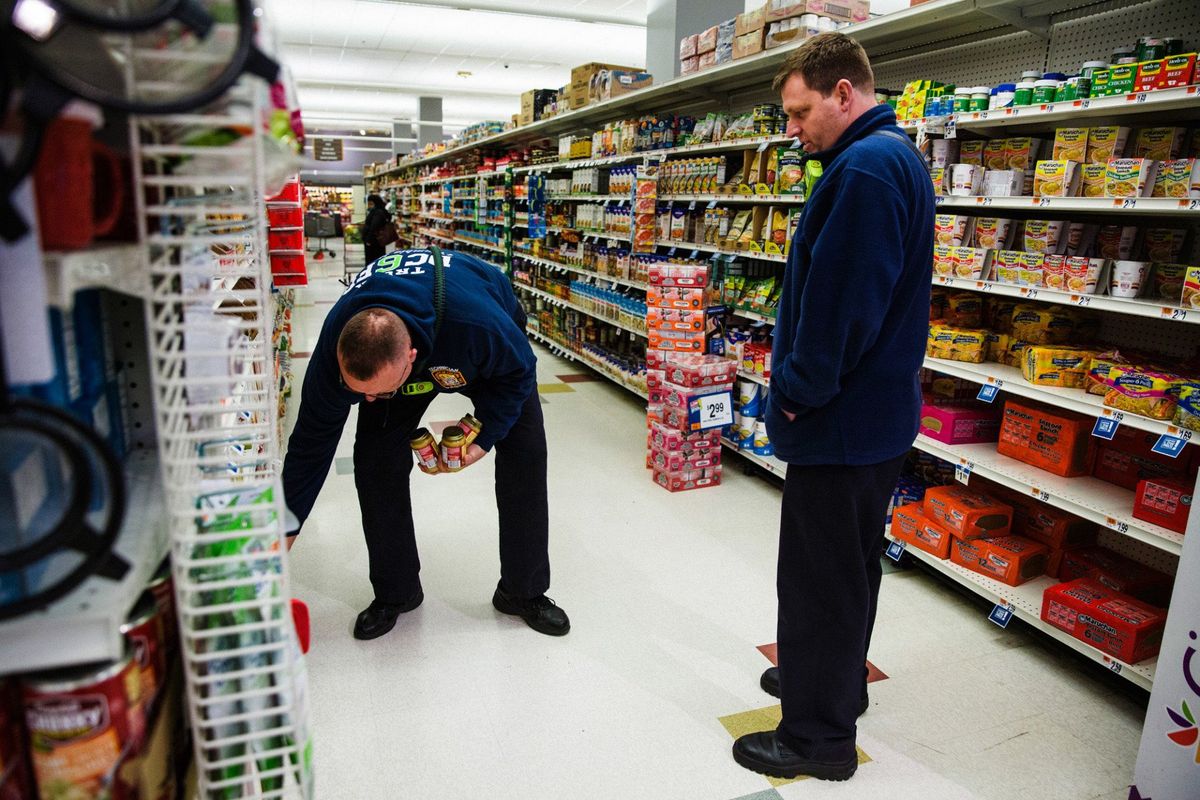
Firefighters from Truck 6 pick up a few items needed to prepare a meal for dinner. Photograph by Erica Baker
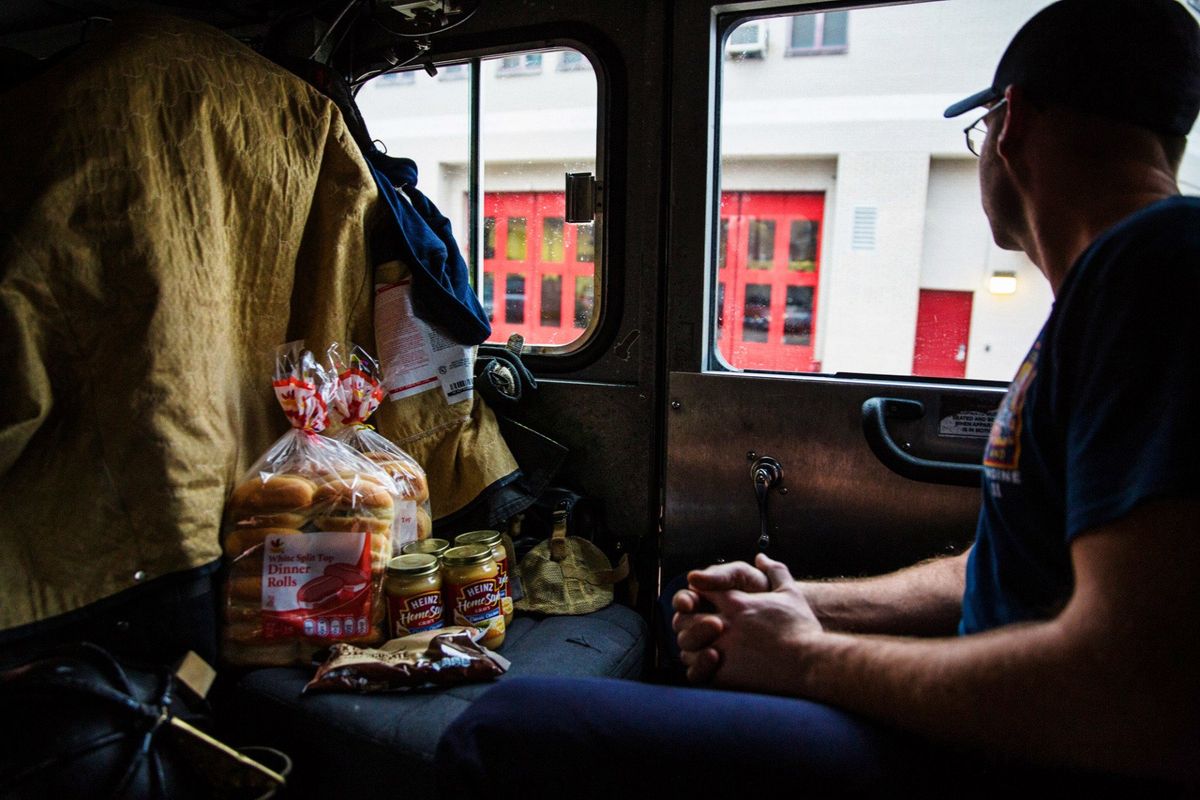
Groceries for the day's dinner rest on a seat in the fire truck after a last minute grocery run. Photograph by Erica Baker
Da’Von, too, was quick to inform me of the same: Firefighters buy their own groceries, cook their own meals, buy their own toilet tissue, paper towels, sauces and spices, TV. Even bedsheets—they bring their own, which explains the long, inhospitable room of bare, blue mattresses.
With Jonathan’s advocacy and leadership, a few local grocers and businesses have actually taken notice and begun to partner with Food on the Stove to offer highest quality meats, fish, and produce to the firehouses at a discount. These include Yes! Organic Market, as well as Harvey’s Butcher Shop and the District Fishwife—both in Union Market.
Fiona Lewis of District Fishwife. Photograph by Erica Baker
"It's such a great cause, and eating healthily is important for all of us, but especially for those of us who are constantly putting their lives in danger."
Fiona Lewis
District Fishwife
So firefighters buy their own food yet seem to struggle, as a culture, to connect the ‘heart attack epidemic’ to food and fitness in any meaningful way.
“I think it has not been top priority because our priority has always been helping others,” says Captain Barnes. “For a long time, the providers weren't the priority—we put ourselves last. But Food on the Stove is bringing to light our health and wellness and nutrition, and how we should really be taking care of ourselves first, so we can be healthy to take care of others.”
“Really, it's just at the end of the day, it's really about looking out for one another. It's really about wanting to serve fire fighters, wanting to see people that you work with on a daily basis be healthier. I mean, I don't think there's any harm in caring.”
Jonathan Tate
Founder, Food on the Stove
Fire in the Belly
“I believe that firefighters deserve the best of everything. All these guys are working hard, they chip in to prepare the meal,” says firefighter Tate, “that's where Food on the Stove steps in. We try to supplement the cost of meals in the firehouse. We partner with other companies to make those healthier options more affordable for firefighters because we realize that it does cost to eat healthy.”
“As our nutritionist on staff always says, ‘You can pay for the food or you can end up paying for medication, but you're gonna pay for it either way.’ We're just trying to shed some light, share some education to help the firefighters.”
Jonathan Tate
Founder, Food on the Stove
Every month, on his day off, firefighter Tate arranges his team to cook a meal at a firehouse. That house gets chosen by the house that got it before—so each house pays it forward, so to speak. Tonight we’re at Engine 10 and Tate has bought all the groceries for Chef Brazil Murphy to work his magic on some chicken, shrimp, asparagus, and salad. Printouts are placed neatly at each seat around the table, and nutritionist James Tate explains the topic of the evening—reading a food label:
"Most people only look at the front label, but never look at the back label,” says James. “Look at a bottle of salad dressing, for instance. They’ll say, ‘Oh this is only 120 calories, but that's 120 calories per serving. A serving size of salad dressing may be a tablespoon. Nobody uses a tablespoon of salad dressing—you just pour it all over your salad, maybe using four or five tablespoons. If you do that, if you use five tablespoons, you're at 600 calories just in salad dressing. Then you add chicken, and cheese, or whatever else you put on your salads. Now, you thought you were eating healthy, but you're not.”
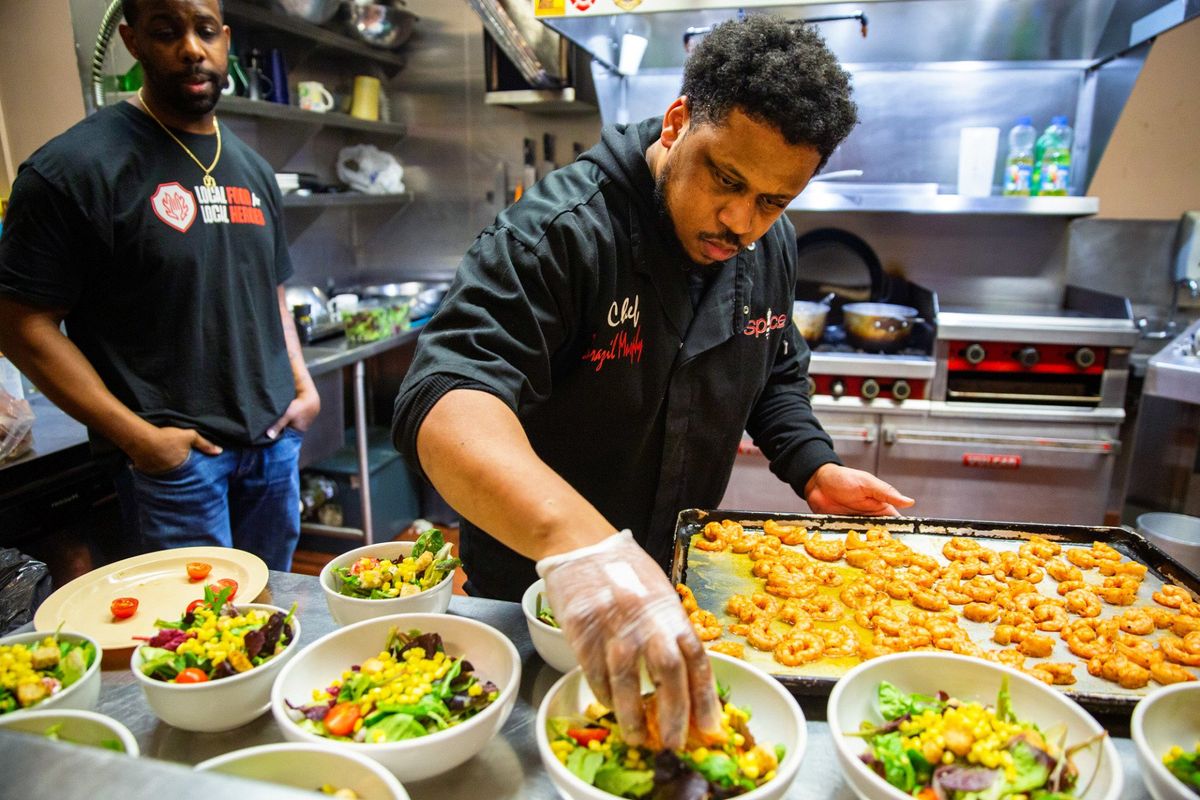
Chef Brazil Murphy plates shrimp salads as part of the Local Food for Local Heroes dinner. Photograph by Erica
Baker
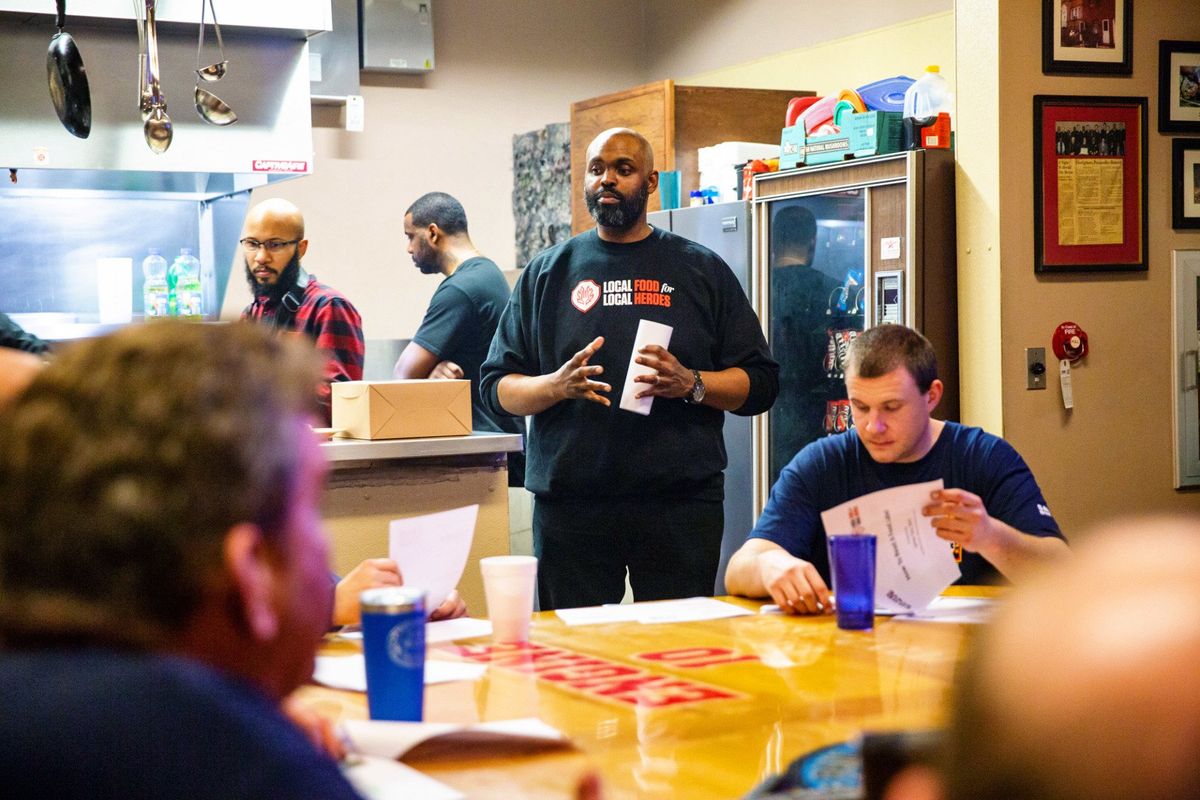
Nutritionist James Tate teaches firefighters about food labels. Photograph by Erica Baker
But that’s not all. “Then there’s the sodium intake,” James explains further. “The sodium may be 11% of your daily value, but if you have five serving sizes that’s 55%. Again, add chicken and cheese, you may be at 70-80% on one meal—not including breakfast, juice, snacks, and dinner.”
"So, most of us are eating 200% of our daily value in sodium, and over eating in calories, and wondering why we can't lose weight, why we're still on medication, but we're eating salads every day,” says James, and the men all nod.
Firefighter Tate is doing the dishes as Chef Brazil tests the chicken: “We're trying to show them how to prepare a meal with local food, the least processed stuff we can get. So, everything is locally grown, locally sourced. No processed anything, and we just prepare a great meal for them.”
Chef Brazil Murphy prepares the meal for the Local Food for Local Heroes dinner. Photograph by Erica
Baker
Beyond the Local Food for Local Heroes dinners, Tate is continually trying to build more partnerships with quality food vendors throughout the city to help make the best choices a bit more affordable for the life of the firehouse.
Captain Barnes is first to commend the work, as she has seen the impact personally: “Like I said, my husband's a firefighter also, and we want to be around for our little daughter. We're slowly making those changes to a healthier lifestyle and I think the catalyst was Food on the Stove, just to bring the highlight back to health and wellness.”
“Nobody ever wants to be in that position where you're on a plaque, or you're on a tee shirt, or you're remembered down at the training academy. Even if we change one mindset, we change one individual, hopefully, we have that ripple effect where that one guy now has changed the whole crew, and then the crew is a battalion…it makes a big difference.”
Lt. Jan Sipes
Health and Safety Co-Chair, DC Firefighters Association, IAFF Local 36
The District
“See all these pictures are the fighters that have fought over the years. Let's see, this is maybe a line of duty death date plaque…the box 654, July 27th, 1910,” says Jonathan. The walls surrounding the dining area at Engine 10 are covered with old photos and plaques explaining how the ‘House of Pain’ got its name. “
The city, historically, has always been busy. This firehouse was probably one of the busiest in the nation. I know, before I got here, they were turning the wheel probably 30 or 40 times a day, going out the door. The House of Pain is a well-earned name, because they don't really sleep, ever,” says Lieutenant Sipes.
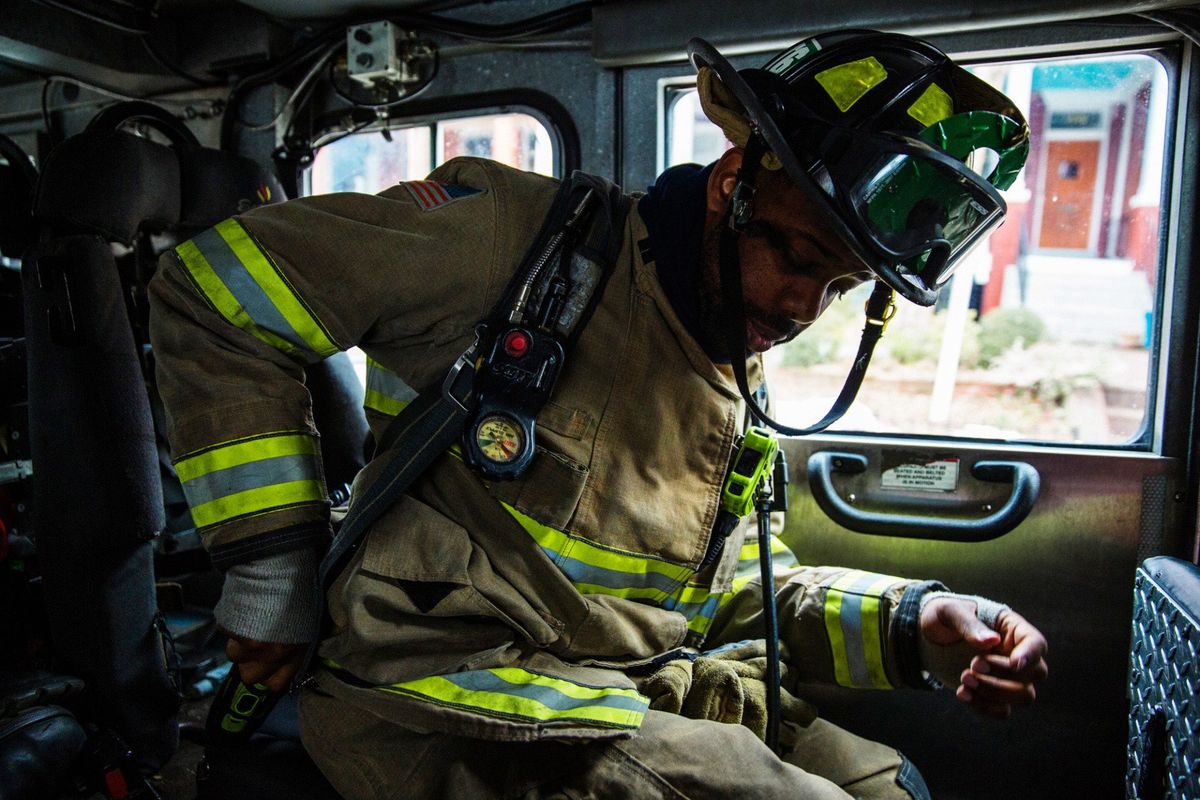
Jonathan Tate checks his radio as his truck company responds to a fire call. Photograph by Erica
Baker

Firefighters from multiple engine and truck companies help load hoses on the back of an engine after distinguishing a fire. Photograph by Erica
Baker
Last year, the district fire department ran about 220,000 calls. “We're the only department that protects the Executive branch, the Legislative branch, and the Judicial branch of government,” says Fire Chief Gregory Dean. “This is a city that has a tremendous number of first amendment marches and rallies, we also have to be prepared for that, and we're the only department that also must be there every time the President takes off in a helicopter. Yet we must also continue to provide the same level of service to all our residents throughout the district. It’s a fun job.”
But Chief Dean also acknowledges we have a long way to go when it comes to prioritizing health and wellness within the fire service: “We need to be better at teaching our members how to take care of themselves, how to eat right, and how to fuel their bodies so that they can be productive athletes.”
Gregory Dean, Chief of DC Fire and EMS. Photograph by Erica Baker
Chief’s wisdom is: If you give yourself half the time that it took you to get out of shape to get back into shape, you’ll be amazed how quickly you see progress.
“You can set aside time even on shift to work out,” says Captain Barnes. “Yes, it may be interrupted due to an emergency, but if you set aside time within your company to focus on health and wellness, I think you'll see a shift within a short period of time.”
At the firehouse, Lieutenant Sipes is already seeing change: “I think that the fact that we're talking about that kind of stuff, the fact that Jonathan is doing this kind of stuff, it's making the rank and file guys talk about it. Whether or not anybody is really comfortable, or they're embarrassed, or they don't even know what the right course is for how to eat, or how to drink, or even how to exercise, once that subject is broached at their firehouse, it's an all-in thing. The guys are talking about it.”
Sgt. Thomas Williams, Engine 8 Photograph by Erica Baker
Across town, at Engine 8, Sergeant Thomas Williams echoes and emphasizes the need for education: “We get the word out about the potential toxins that we are taking into our bodies on the calls that we're running, like the fires and the smoke that we are inhaling. I think that same thing should go with changing our tactics in the things that we're eating and what it's doing to us—treat them the same way.”
And that’s the crux of it, that’s where Food on the Stove comes in.
“If the department and people are a little more invested in seeing firefighters healthy, I think we can start to kind of put a dent into what's happening.”
Jonathan Tate
Founder, Food on the Stove
Memorial Overhaul
The gym at Engine 6 is large for DC firehouse standards—many firehouses don’t have a fitness space at all—but still it feels more like a storage unit for old exercise equipment than anything even slightly motivating. In honor of Lieutenant McRae and as an investment in health and wellness, Food on the Stove is renovating the gym with new equipment, a mural, and relevant workout trainings that focus on building the heart.
The new gym will be revealed on May 6th, Lieutenant McRae’s line of duty death day.
“We'll start with Engine 6, and try to build them a space that first honors Lieutenant McRae, and remembers him, but also a reminder to other fire fighters that our health needs to be a priority. I believe this gym will begin to set the standard,” says Tate.
A welcome new standard, I think, having toured the small basement room at the House of Pain where a bench sits on a treadmill and an old punching bag lays dead next to miscellaneous dumbbells. “
A lot of it has to do with the budget,” says Jonathan. “We have a lot of other things that take priority. But, that's where Food on the Stove comes in, we want to make sure that fire fighters get the best of everything.”
“I think this is great that this is going to be part of Kevin's legacy,” says Lieutenant Sipes. “When I heard Jon talk about the fact that they're going to put a gym in 6 Engine, that's awesome. Six is a busy place, with a truck there too, and you hope that they'll be able to use it. Maybe not while they're working, but on their day off they'll be able to get in there and use the gym. And if we can get down there, it would be nice if we could use it too. I think it's going to be a great opportunity for the fire department.
As a younger firefighter, Da'Von McRae is often tasked with cleaning up after meals – a task he has come to enjoy as service to his colleagues. Photograph by Erica Baker
“I want his legacy to continue to live forever. I'm real proud to be his son, and real proud to have his last name. Everywhere I go, my father's with me. Every job shirt I have, he's right there. I'll follow in his footsteps, but I want to be my own person. Yeah, and lead that revolution of good tasting, healthy food.”
Da'Von McRae
DC Firefighter/EMT
As for the community’s part, Food on the Stove is eager for broad participation: “We're showing you the problem in the fire service—one of the problems being heart disease. That's where you can help. You can donate money, you can offer your prayers, encouragement to fire fighters when you see one, ‘Hey thanks for what you do. You're doing a great job.’ I think all that goes a long way,” says Jonathan.
And maybe consider bringing a box of fruits or vegetables instead of cookies, cakes, and brownies.
Support Food on the Stove
Food on the Stove is a Washington DC based non-profit organization that increases awareness about health and wellness within the fire service by providing tools and resources to help members maintain healthier lifestyles with heart healthy eating practices and fitness activities.
Donate
Follow Us
Made by Bittersweet Creative
© 2019 Food on the Stove
